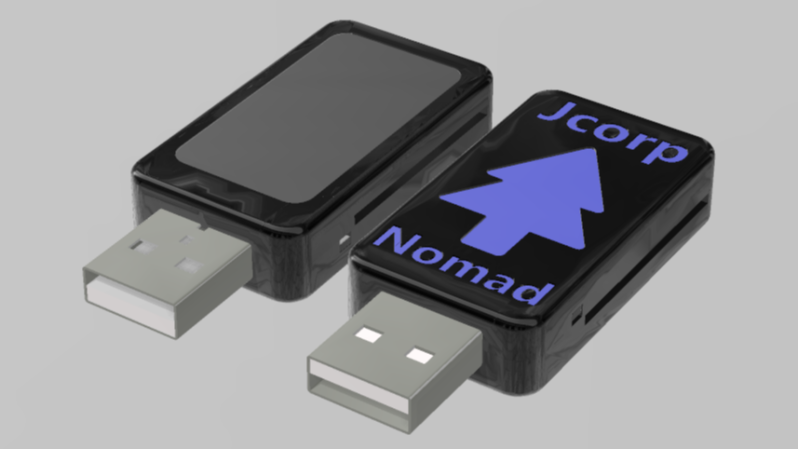[Jackson Studner] wrote in to let us know about his ESP32-based media server: Jcorp Nomad.
This project uses a ESP32-S3 to create a WiFi hotspot you can connect to from your devices. The hotspot is a captive portal which directs the user to a web-interface comprised of static HTML assets which are in situ with the various media on an attached SD card formatted with a FAT32 file system. The static HTML assets are generated by the media.py Python 3 script when the ESP32 boots.
This project exists because the typical Raspberry Pi media server costs more than an ESP32 does. The ESP32 is smaller too, and demands less power.
According to [Jackson] this ESP32-based solution can support at least four concurrent viewers. The captive portal is implemented with DNS and HTTP services from the ESP32. The firmware is an Arduino project that integrates a bunch of libraries to provide the necessary services. The Jcorp Nomad media template supports Books (in pdf files), Music (in mp3 files), and Movies and Shows (in mp4 files). Also there is a convention for including JPEG files which can represent media in the user-interface.
And the icing on the cake? The project files include STL files so you can 3D print an enclosure. All in all, a very nice hack.















Dam, this is smalller than my Raspberry Pi Zero 2 W media server.
https://hackaday.io/project/199227-pi-zero-2w-mini-dlna-server
Very nice idea. But…
I would like the addition of flac and wav support for music.
I suspect that would be an easy add. Maybe submit your patch! :)
I am so on it
Nice project for the LilyGO T-Dongle-S3 i have lying around ;)
Oooh, that looks like a nice device, but I can’t figure out if the SD (TF) is accessible or not? Liligo website states “Note: With TF Card, but TF card has no function.” ?!?
I am actually writing the code for Tdongle right now! It behaved weird but I can confirm the SD card works.
You might want to change the name of your media example to big buck bunny or something else.
Same with the book use one that is public domain, any book or audio book from “project gutenberg”, a project that has been about since 1971. Maybe Bram Stokers Dracula.
Yea that’s a good point Ima do that now, I didn’t think this project was going to get so many views lol
Not to be confused with the same-named device invented by Jackson Roykirk.
THIS! THIS is a top 10 comment right here! Made my day lmao.
Now I’m going to be distracted wondering how he’s listed as appearing in both ST:TOS and Picard, with only one actor credited for playing the role… who died in 1989.
Just needs a chat Feature and it can replaced to old pirate Box.
Check out the pirate nomad fork, someone did just that, it’s awesome!
Brings me back to my AirStash days!
Fat32 is an outdated file system 👎🏼
Perhaps, but its also simple and readable just about anywhere. And for a media filled SD card the limitations of the FAT32 really won’t apply – I’d actually suggest it is the optimal choice for this task, though I wouldn’t object to using something else either, as it really isn’t very important as long as the brain of this project can read it without choking so it can actually do the job.
He is right, fat32 blows. But it’s really really good for this specific use seeing as esp32 only support fat32 🤣. The bigger brother of this project in the works will support newer systems, it’s just not going to be as small!
you’re not thinking like an embedded developer
It is nice and small. But the ESP32 board used is the same price as a Pi Zero W.
Soon I will have support for the lily go tdongle, which can be had for much less! Just a pain to work with 😅. Also looking at support for the esp32s3 super minis, which while not great and probably only good for 1 stream, are only $1-2 from sketchy sites!
The bigger studio version (4k support) actually will run on a raspi zero 2 w so you will get a bit more bang for your buck!
This would be great to run on the m5stack cardputer!
has anyone actually gotten this to work?
the libraries are all over the place version wise the includes reference files not included and after hours it will not compile, only errors after errors and that is not even including the fact that links are to affiliate sites and the software referenced is full of adware and malware
Thanks for letting me know. I really wanted to recreate the project, probably my time is better spent elsewhere.
Howdy! It’s mentioned in the docs but if you hit library errors I included the full library file as a zip under versions on GitHub, should make your life a bit easier!
If you are still having issues send your error log on GitHub, would be happy to help you get it up and running!